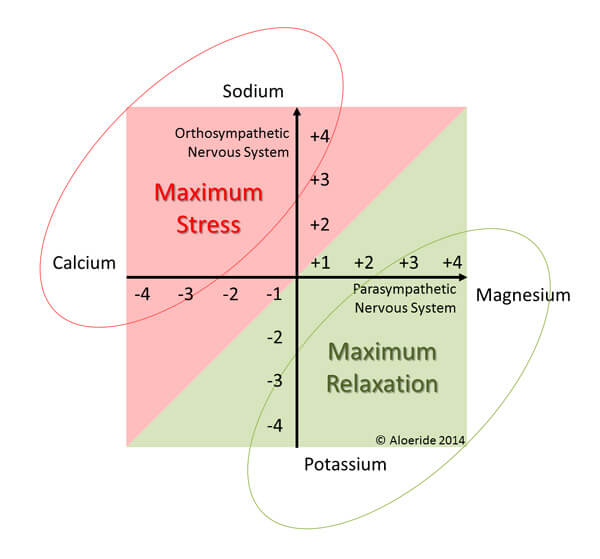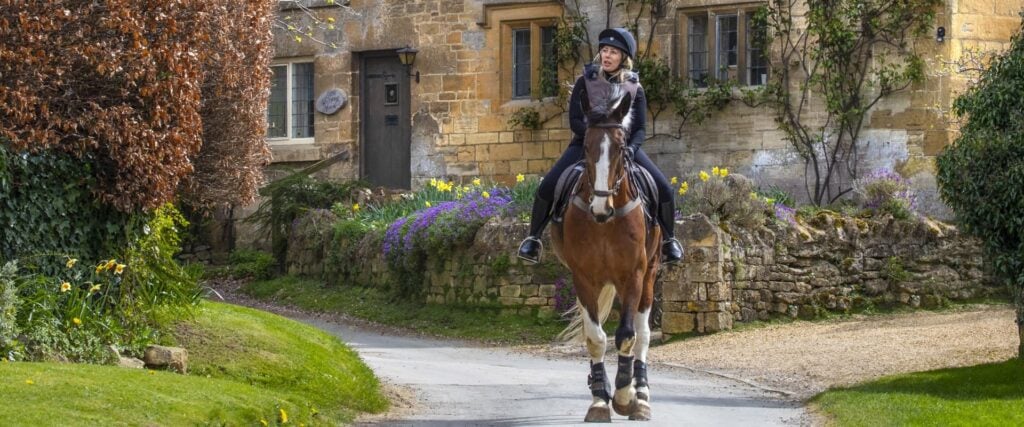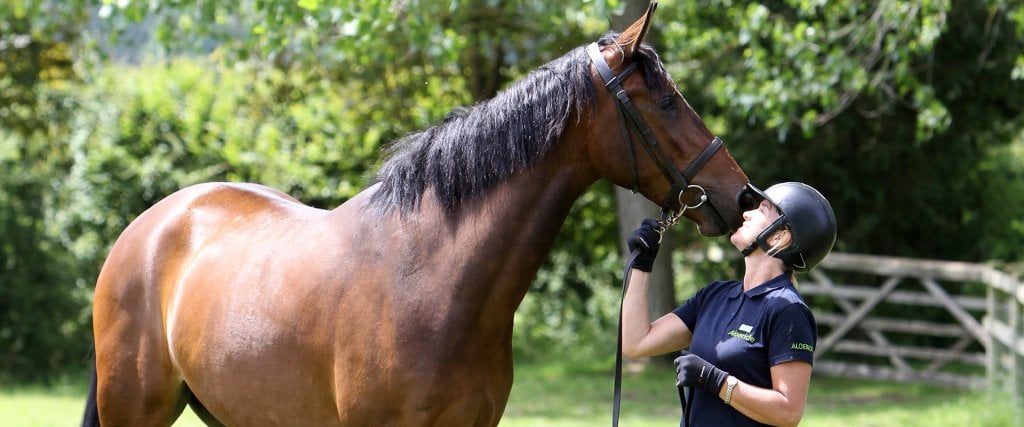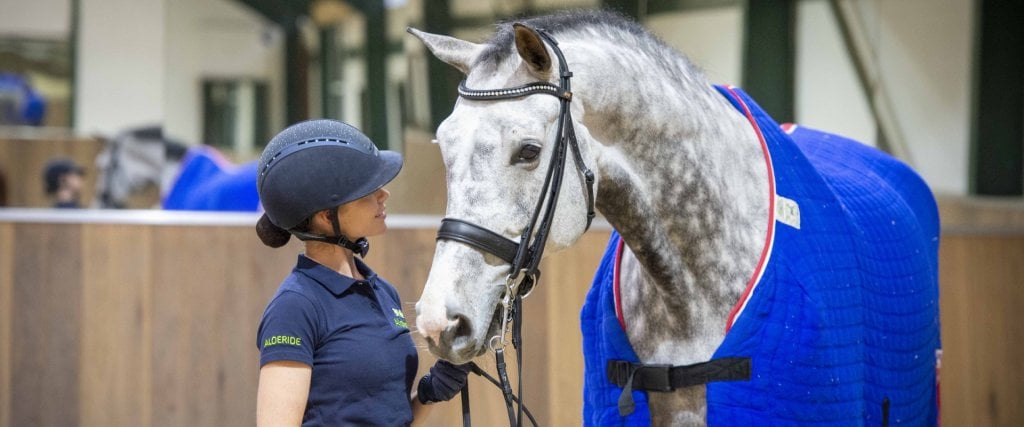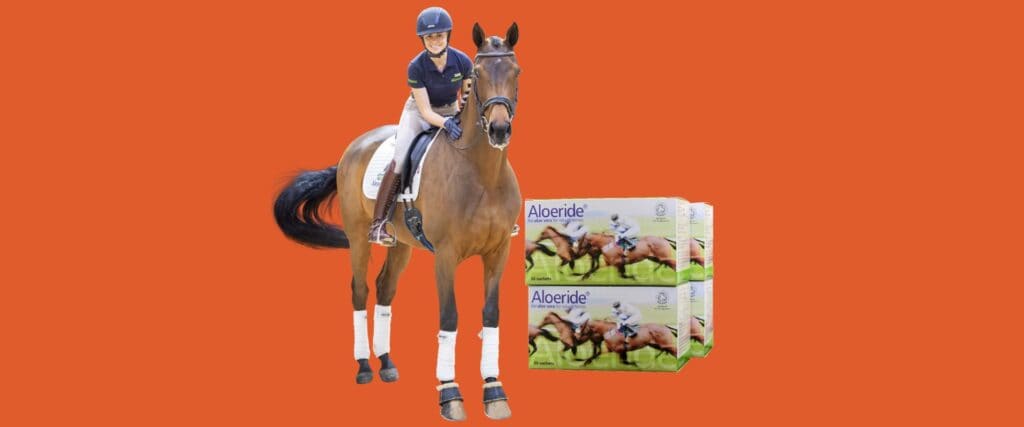Horse Calmers Explained
From talking to competition riders and to people riding out, it is clear that there’s no one ‘calmer’ that works for every horse. If you are interested to know why and find out what to do instead, then this Horse Calmers Explained page is perfect for you. Particularly competition riders feel a need to get their horse less tense prior to a travelled-to-competition. In an ideal world you want the coolest, unstressed horse that retains high attentiveness to your subtle commands, that retains quick reflexes and reaction time. Some of our customers started out looking for horse calmers for spooky horses.
The horse calmer most riders don’t know about
A pretty consistent feedback from riders with horses on Aloeride is that their horses are better behaved. Temperamental and spooky horses become more manageable and the reason for this – from our perspective and that of the scientific community – is that a meaningful improvement in the digestive system often is followed by a meaningful change in mood, cognition and behaviour. This means that your horse is more receptive to training and is more likely to be calm(er) during performance. Your horse remains alert to your subtle directions as you haven’t sedated it with ‘guess what will do the trick today’ dosages. When you click on the above image, it enlarges so you can read precisely how this gut-brain-axis works. Horse calmers for spooky horses must start in the gut. One sachet of Aloeride a day improves baseline calmness and fair enough, if your horse feels nervous at a competition, you may want to feed an appropriate amount of L-Tryptophan. Horse Calmers Explained doesn’t address in-the-saddle nerves affecting your horse’s flight response.
“The enteric nervous system uses more than 30 neurotransmitters, just like the brain, and in fact 95 percent of the body’s serotonin is found in the bowels”. Professor Michael Gershon, chairman of the Department of Anatomy and Cell Biology at New York–Presbyterian Hospital/Columbia University Medical Center
Shift the balance towards calming
For fullness of information: There are two biochemical ways via which you can influence the relaxation of your horse (i.e. exclude acquired behaviour): 1) via the balance between Orthosympathetic and Parasympathetic Nervous System and 2) via nutrients that affect brain chemistry. In clinic Han van de Braak BSc LicAc MCSP MBAcC (Retd.) used an orthostatic test that measures how well patients can switch from relaxation to stress and back to relaxation again; how adaptable their Autonomic Nervous System (ANS) is. Aspects of their electrocardiogram go through an algorythm which then is graphed like the picture here. This test does not exist for horses but the picture helps you grasp what is involved. You are familiar with a twitch, a rope looped around the upper lip of your horse and twisted to exert pressure (using the acupuncture points GV 26 and 27 to affect the brain – we know that and how this works from a research model of cerebral median artery occlusion (MCAO). A twitch relaxes your horses because it quickly raises the tone of the Parasympathetic Nervous System (PSNS) – i.e. more to the right on the horizontal axis. A similar shift of tone you can achieve by a nutrient shift that affect the Autonomic Nervous System.
The orthosympathethic branch is the fight or flight system, the parasympathetic branch is the rest and digest system (which includes healing and regeneration). To see your horse calmer you’d want the PSNS switched on and the OSNS switched off, this is what free divers are experts at doing, they consciously manoeuvre their ANS into hibernation. That just goes to show how pliable and effective this system is!
Calcium and Sodium raise the Orthosympathetic tone (stress) whilst Magnesium and Potassium raise the Parasympathetic tone (relax). You now know that in ‘calmers’ that contain chelated Calcium, the Calcium cannot possibly cause the effect because it pulls the ANS in the opposite direction. Calmers based on chelated Magnesium will only ever improve muscle relaxation (de-contraction) if your horse is actually Magnesium depleted. Magnesium Glycinate provides the highest levels of absorption and bioavailability (more than Magnesium Citrate and way more than Magnesium Choloride) but Magnesium Taurate combines Magnesium and the amino acid Taurine which is why that type would be the most useful for a stressed horse. The best horse calmers for spooky horses are broader spectrum rather than only Magnesium. You must however maintain the proper balance between Magnesium, Calcium, vitamin K2 and vitamin D3. Longer term nutrient loading with a right-for-your-horse feed plus Aloeride tends to make ad hoc Magnesium obsolete.
Brain nutrition
Many nutrients affect brain chemistry but within horse calmers you’ll find a lot that have L-Tryptophan as one ingredient. This is an essential amino acid and the precursor of serotonin. An increase in this neurotransmitter in the brain has been associated in numerous studies with a rise in sleepiness or sedation, and decreased aggression, fearfulness, mania, insomnia and pain sensitivity. Tryptophan is converted to serotonin via a two-step reaction, the first and rate-limiting step is the conversion of L-tryptophan to 5-hydroxytryptophan (5-HT), catalysed by tryptophan hydroxylase (which is Ca2+ and Fe2+ dependent). The delivery of circulating tryptophan to the brain and its conversion to serotonin vary directly with plasma concentrations of tryptophan and inversely with those of other large neutral amino acids (LNAAs) – that is because there is competition between tryptophan and the LNAA for carrier binding sites.
That explains why giving L-Tryptophan ad hoc to horses on high protein diets doesn’t work so well. Insulin lowers the LNAA concentration in blood which increases the uptake of tryptophan by the brain, that is why giving your horse a little honey prior to a competition could very cheaply raise serotonin levels… Carbohydrate diets decrease free tryptophan but increase brain tryptophan levels. [Source: Madras BK, Cohen EL, Fernstrom JD, Larin F, Munro HN, Wurtman RJ: Dietary carbohydrate increases brain tryptophan and decreases serum-free tryptophan. Nature 244:34-35, 1973] Another trick is to feed your horse free fatty acids because, like tryptophan, these also bind to blood albumin which is why you’d end up with more free plasma Tryptophan and ultimately more Serotonin production. Thus, better dietary management is more appropriate than Tryptophan supplementation in many cases. When it comes to calming your horse think ahead and avoid ‘poor planning on your part does not necessitate an emergency on mine’ (a derivative of the 7Ps).
A dosage for your horse depends on protein, carbohydrate, lipid intake and anxiety level. Test what dosage works for your horse and see how quickly that kicks in, most people administer it 1½-2 hours prior to competition. Toxic effects on the blood and respiratory system occur in ponies following oral tryptophan at 350mg/kg [Source: Paradis, M.R., Breeze, R.G., Bayly, W.M., Counts, D.F., Laegreid,W.W., 1991a. Acute hemolytic anemia after oral administration of L-tryptophan in ponies. American Journal of Veterinary Research 52, 742–747.] and this equals 175 grams for a 500kg horse. That would be more than one tub per helping if you’d use a 908gram tub of which L-tryptophan is 14.3% of the content (i.e. 129.84 gram L-tryptophan/tub). Interestingly a leading multi-national pharmaceutical compound operation charges £15,985.64 per 100kg of L-Tryptophan, so, if manufactured with such quality ingredients, these 129.84 gram alone would cost £20.76 in raw material. All too often corners are cut to lower the price…
I always refer to nutrient-intake, nutrient-uptake, and nutrient-usage to get a grasp of what might be in the nutrient ‘current account’. This crops up here again because, if your horse has a low-to-moderate intake/uptake of vitamin B3(niacin), then Tryptophan is used to make B3 in the liver at the astounding ratio of 60 mg Tryptophan to make just 1 mg of vitamin B3. And you wonder why a dosage doesn’t hit target… If a horse is low in B3 then very clearly you’ve got the feed and supplementation wrong, that could be sorted easily between Aloeride and a manufacturer-independent Equine Nutrition Consultation!
Here is your introductory Aloeride Offer!
Give your horse 12 litres of Soil Association Organic Aloe Vera Barbadensis Miller in 30 palatable powder servings. One supplement with many benefits to your horse (and you)..
Equine Mind
Not infrequently, when a horse is routinely not calm, there is more awry than only physiological issue(s) or physical stress. Horses are prey animals. To survive, they need their instinctive flight (or fight) response to anything that is even slightly out of the ordinary. Their walnut of a brain is very capable of remembering past stressors and behaviours (includes previous owners). Sometimes a flight or fight response is ‘just’ a behavioural vice. It is well known that horses with limited stimulation or socialising throughout their day get bored, frustrated and potentially irritated. If you’re a parent then you’ll know that not giving an intelligent child engaging challenges (to solve) at school or at home will result in disruptive behaviour. Same goes for your horse. Calmness may need training, that is, building confidence so as to overcome fear. Desensitising can reduce the flight response to flags, crowds, lights, plastic bags or loud noises. You also know that that if you are anxious, worried, or tense, your horse is likely to be too… Courtesy of large nostrils picking up your pheromones and large ears picking up your breathing rate. Stabled life with limited daily turnout can have serious impacts on your horse’s mind and emotional state. If your horse is routinely not calm and spends a significant time in stables then why not try out /give-horse-tune/.



